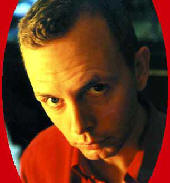 Duncan
Millar Duncan
Millar
|
|||
| The album was written and demo-ed in my
home studio, located in a converted air-raid shelter in my back garden
in North London that narrowly escaped destruction in World War 2! It was
later completed in a converted attic, home of Ernie McKone's studio
Boogieback, in which he previously worked with Count Basic and Brian
Tarquin among others.
While working on this album I've been thinking about the route I've taken in music which has resulted in its creation. I started me on the piano at an early age, but I think it was probably listening to my dad play bits of Boogie-Woogie piano and George Shearing's "Lullaby of Birdland" that first opened my ears to the possibilities of jazz harmonies. I wanted to play chords like that and I can still remember the thrill I got when I found my first dominant seventh chord! Luckily, a neighbour was not only an Oscar Peterson fan, but also happened to be a personal acquaintance, and I can remember spending half an hour with the great man backstage at the London Hammersmith Odeon as an awe-struck teenager. I was also fortunate to have a school-teacher who later made me aware of other pianists such as Bill Evans, Art Tatum, McKoy Tyner, Kenny Barron, Herbie Hancock and Chick Corea. Soon I began subscribing to Downbeat magazine, - at that time it seemed unreal that it came all the way from Chicago, which seemed so far away it might as well have been on another planet! Reading about the jazz scene in the States made the London scene seem tame, (acid-jazz had not yet arrived!) but I had heard of several well-known UK musicians who had gone to a college in the US called Berklee and thought that I should go too. I eventually arrived in Boston without much money only intending to stay a few months, but after a rough stay at the YMCA I managed to get some funding from the college and ended up staying two years! I don't know whether maybe I rather O.D.'d on jazz at Berklee, or whether the jazz scene in London didn't seem to present many more opportunities than previously, but on my return to London I found myself getting more into pop and dance music. Several years activity as a producer and performer followed with several chart successes both in the US and UK, leading to tours, TV appearances and releases on MCA, EMI and Virgin, among others. Exciting as that was, I began to feel that it was not really fully exploiting my abilities as a player and in particular as a jazz player. Finally I saw an outlet in the newly developing acid-jazz scene and this led to a release under the name A One, which was a fusion of my interests in acid-jazz and contemporary dance music. Several of these tracks were released on Instinct's This is Acid Jazz label and brought me into contact with the label. As with A One, the tracks on this album were originally self-performed and arranged in my North London demo-studio and were influenced not only by some of my favourite jazz players but also some of the jazz-influenced soundtrack-writers that I have always admired. With Ernie McKone's input and performances by some of London's top jazz-funk musicians however, the music has been taken to a new level. "Dream Your Dream" represents both a progression as well as a return to my original roots. The circle is now complete.
Duncan Millar's album, "Good To Go" is released
on Instinct Records on 26th June 2001 in the US. On 3th March 2002
Expansion Records released his album "Comin' Thru", a
compilation of his albums "Dream Your Dream" and
"Good To Go".
|
|||
|
|